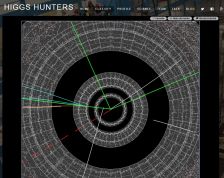Nov 28 2014
Oxford physicists are asking online volunteers to spot tiny explosions that could be evidence for as-yet-unobserved relatives of the Higgs boson.

The Higgs Hunters project launched today enables members of the public to view 25,000 images recorded at CERN's Large Hadron Collider. By tagging the origins of tracks on these images, volunteers could spot tiny sub-atomic explosions caused when a Higgs boson ‘dies’, which would be evidence for a kind of particle new to physics.
"Discovering what happens when a Higgs boson 'dies' could be even more exciting that the original discovery that the Higgs boson exists made at CERN back in 2012," said Professor Alan Barr of Oxford University's Department of Physics, lead scientist of the Higgs Hunters project. "We want volunteers to help us go beyond the Higgs boson 'barrier' by examining pictures of these collisions and telling us what they see."
In the ATLAS experiment at CERN's Large Hadron Collider protons are smashed together at 99.999999% of the speed of light. Such collisions can generate Higgs bosons: these are known to rapidly decay into other particles and some scientists believe these could include a new type of previously unobserved particle. Simulations predict that these new particles should leave tell-tale tracks inside the ATLAS experiment, which computer programs find difficult to identify, but which human eyes can often pick out.
Professor Andy Haas of New York University, a partner in the project, said: "Writing computer algorithms to identify these particles is tough, so we're excited to see how much better we can do when people help us with the hunt."
Professor Chris Lintott of Oxford University's Department of Physics, Zooniverse Principal Investigator, said: "The most exciting citizen science comes when you find the unexpected lurking amongst the data, and who knows what could be out there in the data from the ATLAS experiment?"
A successful detection of new particles would be a huge leap forward for particle physics, as they would lie beyond the Standard Model – the current best theory of the fundamental constituents of the Universe.
Source: http://www2.physics.ox.ac.uk/